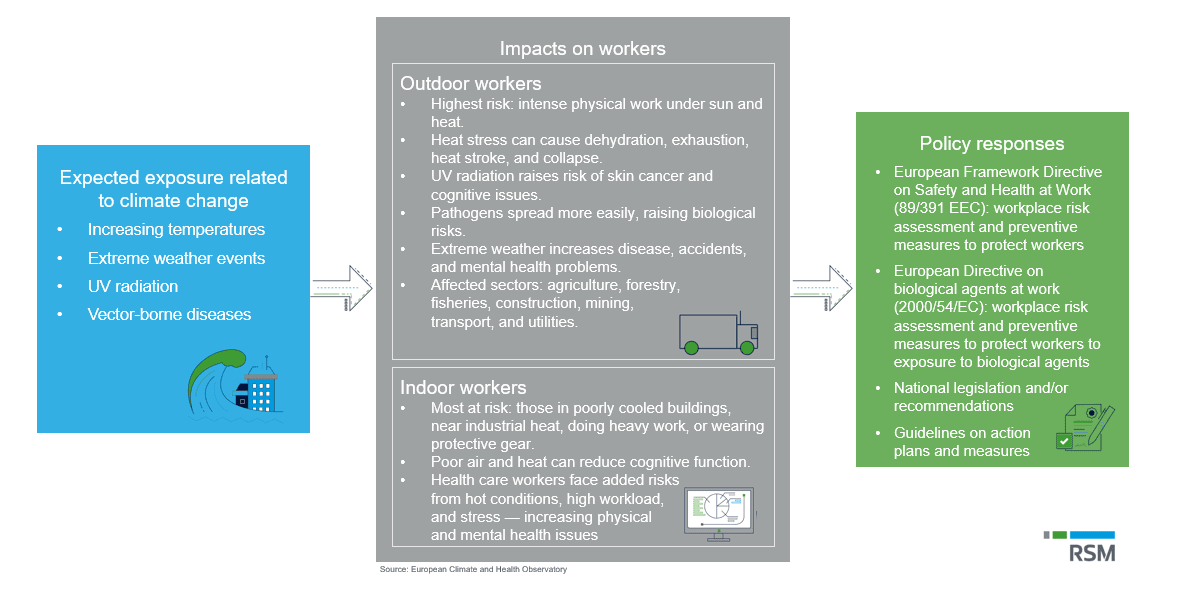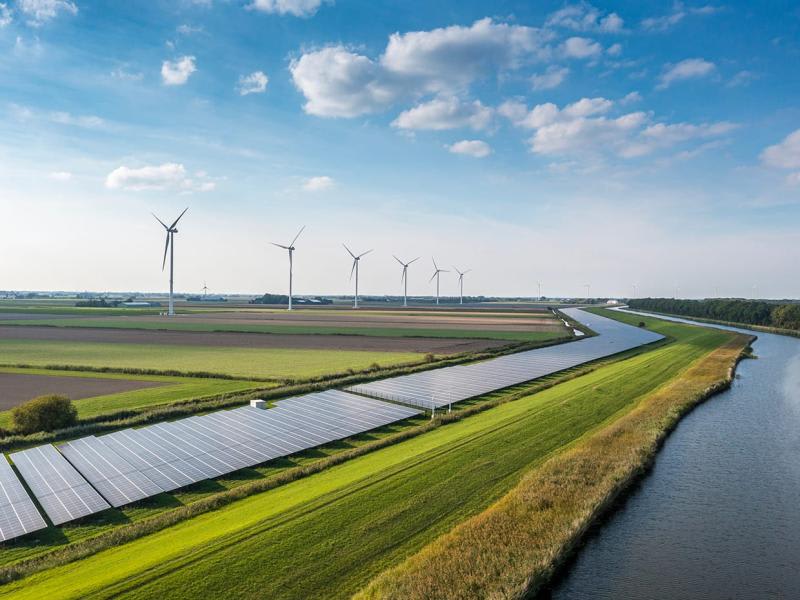Climate change is no longer a distant environmental concern – it’s a daily workplace reality. Across the globe, workers in agriculture fields, construction sites, logistics hubs, and factory floors are increasingly exposed to extreme heat, polluted air, storms, and other climate-related dangers. These hazards threaten workers’ health and productivity on a wide scale.
The International Labour Organization (ILO) warns that 70% of the world’s 3.4 billion workers now face climate-related health risks, from heat stress and air pollution to ultraviolet (UV) radiation and infectious diseases. In fact, excessive heat alone already causes nearly 19,000 worker deaths and 23 million occupational injuries each year.
Business leaders and communities alike are beginning to recognize that protecting workers from climate hazards is not only a moral obligation, but a cornerstone of economic resilience.
Key Climate Hazards
Both the ILO and IOSH (Institution of Occupational Safety and Health) consistently highlight these climate-related hazards in their guidance and reports. Emphasizing their growing relevance for worker safety, since globally, 1.6 billion outdoor workers are directly exposed to climate extremes (WHO):
1. Excessive Heat
Rising average temperatures and more frequent heatwaves increase the risk of heat-related illnesses, such as heat stress, dehydration, and potentially fatal heat stroke. Outdoor workers and those in hot indoor environments are particularly vulnerable.
Beyond the immediate health impacts, heat severely undermines productivity. In 2023, it caused the loss of 512 billion work hours, costing $835 billion globally (WEF). Low-income countries with large outdoor workforces are hit hardest, making excessive heat both a health and economic crisis.
2. Poor Air Quality
Increased temperatures contribute to higher levels of air pollutants such as ozone and particulate matter. Exposure to pollutants, compounded by wildfire smoke, can cause or worsen respiratory conditions like asthma and contribute to long-term lung damage, ultimately making air pollution a major occupational hazard linked to up to 860,000 work-related deaths each year.
In South Asia and Africa, industrial emissions and traffic smog pose daily respiratory risks to outdoor workers. In Europe, wildfires like the massive 2023 fire in Greece, burning over 730 km² and causing multiple fatalities. Exposed outdoor workers to toxic smoke, highlighting the lack of standardized protective measures (apnews.com, Wildfire Northern Greece).
3. Extreme Weather Events
More frequent and severe weather events (storms, floods, wildfires) not only pose immediate physical dangers but also disrupt normal work environments and infrastructure, leading to injuries and increased workplace hazards.
In October 2024, deadly floods in Valencia, Spain, killed over 220 people and trapped more than 1,000 workers in an industrial zone. The disaster exposed major gaps in emergency preparedness and worker protection during extreme weather (wsws.org).
4. Ultraviolet (UV) Radiation
Increased UV radiation is a growing threat to outdoor workers. Long-term exposure without adequate protection significantly raises the risk of skin cancer, eye damage, and other UV-related health conditions.
5. Vector-Borne Diseases
Warmer climates are expanding the geographic range of disease-carrying insects and ticks. This increases the risk of workers contracting illnesses such as Lyme disease and West Nile virus. This shift is especially concerning in regions where such diseases were previously rare, leaving workers, employers, and health systems less prepared to respond.
6. Psychosocial Stress and Mental Health
The uncertainty, increased work disruptions, and the cumulative burden of multiple environmental stressors contribute to mental health issues such as anxiety, burnout, and chronic stress among workers.
Repeated evacuations, unsafe conditions, and economic stress from climate events take a serious psychological toll on workers, yet mental health remains largely under-addressed in occupational risk frameworks.
Building Climate-Safe Workplaces
Faced with rising climate risks, businesses must take a proactive and science-based approach to protect their workers. Building climate resilience at work is now essential to responsible employment. Leading companies are adopting key measures to safeguard health, productivity, and employee well-being, including:
1. Adjusting Work Schedules
To protect workers from extreme heat, employers can shift work to cooler hours, such as early mornings or evenings, and allow flexible scheduling during heatwaves. Options include shorter shifts, more frequent breaks, and rotating tasks. Though these changes may reduce short-term output, they help prevent illness and accidents, ultimately supporting productivity and safety in the long run (weforum.org).
2. Hydration, Shade, and Rest
Employers should ensure access to cool water, shaded rest areas, and regular breaks, which are key to preventing heat stress. Measures like 15-minute rest breaks per hour and cooling stations with fans or shade can significantly reduce heat-related illnesses (ishn.com).
3. Ventilation and Cooling Indoors
Indoor workplaces need better cooling and airflow to cope with rising heat. Upgrading ventilation, adding AC or alternative cooling (like fans or radiant panels), and reducing indoor heat sources can make spaces safer. These steps also improve air quality by filtering smoke or smog (weforum.org, climate-adapt.eea.europa.eu).
4. Protective Gear
Proper equipment can reduce climate-related risks:
- Cooling vests, UV-protective clothing, and wide-brim hats help in heat;
- N95 masks and adjustment of work during poor air quality or wildfire smoke (sourcenm.com).
Standard Personal Protective Equipment (PPE) should be managed carefully to avoid adding to heat stress (climate-adapt.eea.europa.eu).
5. Monitoring and Alerts
Technology helps employers stay ahead of climate risks:
- Real-time weather, heat, and air quality alerts via apps or texts;
- Wearable sensors to detect early signs of heat strain;
- Drones or remote sensors to track site conditions.
These tools support quick decisions, like pausing work during extreme heat or wildfire smoke (weforum.org).
6. Emergency Preparedness
With storms, floods, and wildfires on the rise, businesses need clear climate emergency plans:
- Evacuation procedures
- Safe shelter
- Crisis communication
- Support for essential workers.
Some companies offer paid leave, financial aid, or counseling after disasters, and even set up insurance or reserve funds to cover climate-related work disruptions (weforum.org).
7. Training and Culture
Protective measures only work if workers are trained and empowered to use them. Employers should educate staff on heat risks, air quality, and proper gear use, while promoting a safety-first culture. Pay structures must not penalize workers for prioritizing health, and new or returning employees should be gradually reintroduced to heat through acclimatization programs (weforum.org).
In conclusion, as climate hazards intensify, protecting workers is emerging as a central responsibility for businesses worldwide. It is a mission that transcends compliance, it speaks to basic human dignity and sustainable growth.
Every heat-safe workplace, every worker trained and equipped to handle a wildfire smoke day, every policy that gives employees the power to pause work when it’s unsafe – these are building blocks of a more resilient economy.
Companies that invest in these protections are not only averting injuries and illnesses; they are cultivating loyalty, ensuring continuity, and living up to the value of people first.








